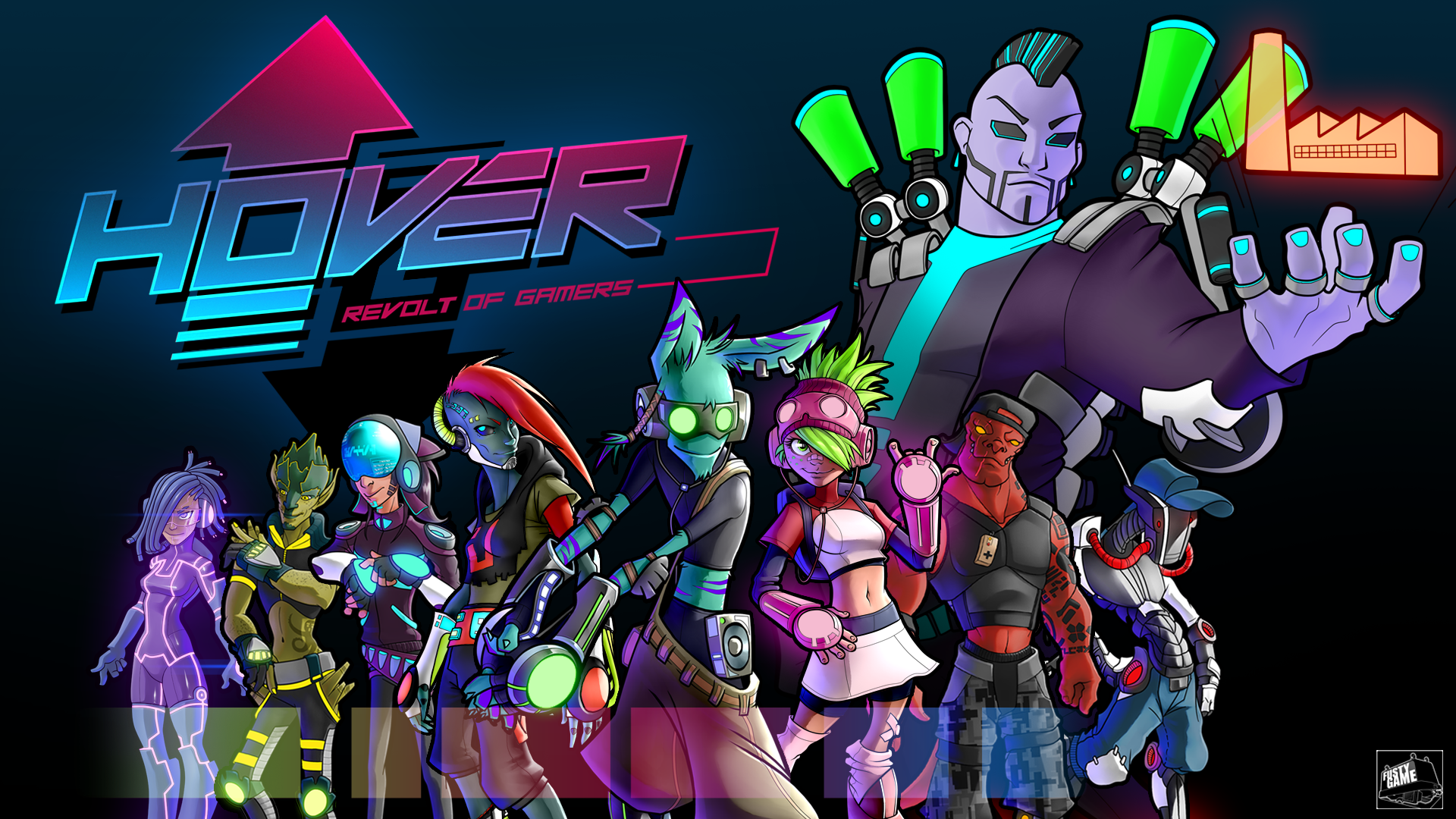When Jet Set Radio (or Jet Grind Radio, as it was originally known in North America), first launched on the Sega Dreamcast in 2000, it represented one of the perfect examples of the kind of promising new gaming endeavours that the new millennium was set to bring. Set amid the backdrop of an authoritarian city that was desperate to keep down the spirited youth, Jet Set Radio stuck out for its streetwise presentation, colourful cel-shaded art style, and innovative mechanics that blended the sensibilities of action-adventure and racing games, with a bit of graffiti-flavoured street mischief to go along with that.
Now, jumping on the train of Kickstarter-funded spiritual successors to beloved game IP’s that their respective publishers don’t seem interested in anymore, comes Hover: Revolt of Gamers, a game that quite proudly aims to be the spiritual successor to Jet Set Radio and its lone sequel, Jet Set Radio Future. Hover has recently come out of Steam Early Access for its full PC release, with console versions for PlayStation 4, Xbox One and Nintendo Switch scheduled to launch later this year. Co-developed by French indie game studios, Midgar Studio and Fusty Game, Hover even goes the extra mile with its inspiration by bringing in original Jet Set Radio composer, Hideki Naganuma to compose a couple of music tracks for the game, while also emulating the same cel-shaded style from Hover’s Dreamcast inspiration.
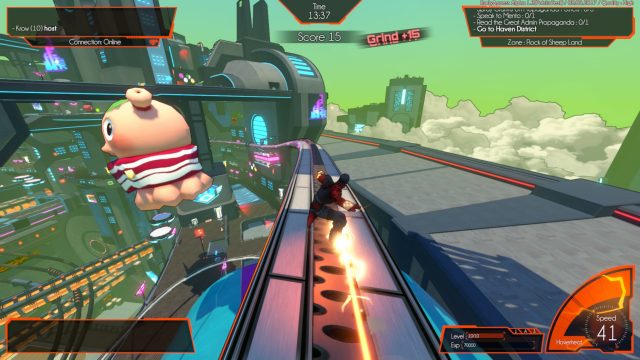
Clearly, Hover demands quite a bit of love for Jet Set Radio from its target audience, though does attempt to take the foundation further with a shared world-esque style, along with new game modes and customizable characters. It’s primarily through these additions however where Hover starts reaching beyond its grasp, since its efforts to marry the classic sensibilities of Jet Set Radio with a more modern, online-driven design don’t always work very well. Zipping and leaping through Hover City is a legitimate blast, and playing certain mission types with a group of friends can be pretty entertaining, but the shortcomings in the presentation and gameplay too often intrude on the experience, making for a well-meaning and slick-feeling game that’s nonetheless more frustrating to play than it really should be.
Hover certainly looks the part of a Jet Set Radio successor, boasting a vibrant cel-shaded art style that has a handful of legitimately great character designs. That’s why it’s frustrating that you have to spend so much of the game playing as a generic hooded gamer clone, which gives you some visual customization options, but not enough for it to matter. The main thing that will separate you from your groups of in-game gamers is the colour of your hoodies and goggles, which feels pretty scant compared to many other shared world and online-driven games.
Fortunately, Hover’s animation is nonetheless crisp and smooth in most cases though, so long as you’re not straining your computer to run the game at a decent level of graphical fidelity. Hover demands a fairly beefy graphics card for an indie game especially, one that comes complete with at least DirectX 11 compatibility, to run on anything above the low settings, even though the rest of the system requirements aren’t too bad. If you have a powerful enough computer however, you’ll find a good degree of customization options for Hover’s PC build, which can do things like add motion blur and better shading effects, which help make Hover City a bit more immersive. Fortunately, the inspired art style isn’t hurt too much if you have to run the game on medium or low settings as well, which it’s better to do if your hardware isn’t up to snuff, since this is a game where any framerate drops will really get in your way during challenges.
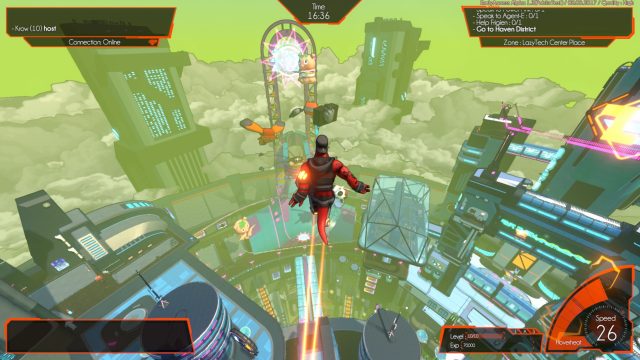
Unfortunately, as much as there’s a good amount of detail and a solid sense of verticality to Hover City, it’s also a fact that Hover’s user interface is a complete mess, and is needlessly difficult to navigate at the best of times. Even with Hover now having had its full release on Steam, the UI still creates the impression of an Early Access game, hitting the player with a messy, convoluted flood of random information that rarely feels intuitive or clean to look at. The menu design feels pretty sloppy too, especially since the menus are only optimized for a mouse, and generally feel very cluttered either way. The complete lack of a minimap during gameplay is also a problem, especially since you have to hold a button for the game to point you towards missions and related objectives, making it more annoying than it has to be to figure out exactly where you’re supposed to go next.
Hover City itself looks inviting and cool at first glance, but it’s a shame that so much of the navigation is so messy. It’s a lot more enjoyable to just leap and dash through the city at your own pace, rather than trying to find your way organically from one objective to the next. This may suit some players fine, but for those who just want to get to each objective as fast as possible amid a sea of random prompts and data, it becomes irritating, since Hover’s interface still feels like a work-in-progress. Eventually, you’ll get used to it, but this unnecessary learning curve to the navigation will make it a lot tougher for Hover to hook newcomers that aren’t actively coming to keep the Jet Set Radio party going under a different name.
Hover’s funky, yet futuristic tunes once again proudly echo the sensibilities of Jet Set Radio, and if that’s the music you’re into, then you’ll definitely be pretty satisfied by the soundtrack. Naganuma’s contributions in particular feel very fitting and enjoyable, and give Hover a great sense of being an homage, without being an exact copy of Jet Set Radio. The frequent record-scratching and synth tunes aren’t going to be universally enjoyed by everyone, but they continue to suit the anti-authoritarian vibe well, and help to give Hover City its own sense of upbeat futuristic charm.
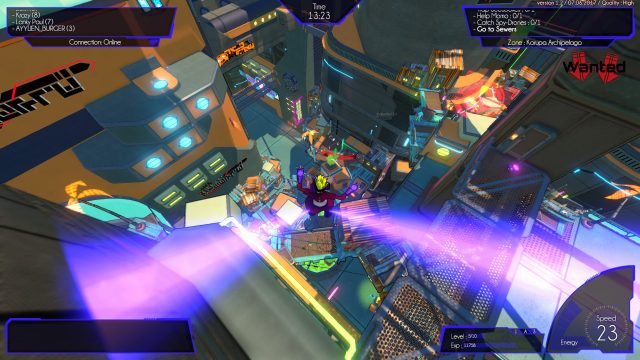
The rest of the audio however is somewhat underwhelming, especially since Hover’s music seems to overpower almost everything else in the audio presentation. Disappointingly, while some of the game’s music features vocals, Hover also doesn’t seem to have any voice acting, with characters instead communicating through simple text boxes. There’s also a lack of power or real satisfaction to doing things like making landings and bouncing around walls and platforms, with sound effects that range from feeling floaty to feeling non-existent. You’ll get a few sound prompts when you do things like perform tricks and build up energy and momentum, but the music still overpowers all of it. Hopefully, you really dig Jet Set Radio-inspired tunes, because that’s the only element trying to make a real impression in Hover’s audio suite.
As I said, when you’re racing, leaping and flipping through Hover City, Hover is highly enjoyable. There’s a great sense of speed and style to the actual physics and sense of movement, especially since you can further customize your character to play up certain skills. Depending on how you place your augmentation chips, which can be found from doing missions or simply finding them lying around in containers throughout Hover City, you can build up a character that is better at running, jumping or doing trick combos, on top of other benefits like faster scanning and hacking, or a superior ability to play Gameball, and more on that in a bit. The solid character customization still suffers from the unintuitive menu navigation, but it’s great that you can nonetheless create the kind of gamer you want, potentially allowing you and your friends to build a balanced team of gamers that all have different navigation specialties for different kinds of challenges, assuming you don’t want to balance your character with even-handed capabilities.
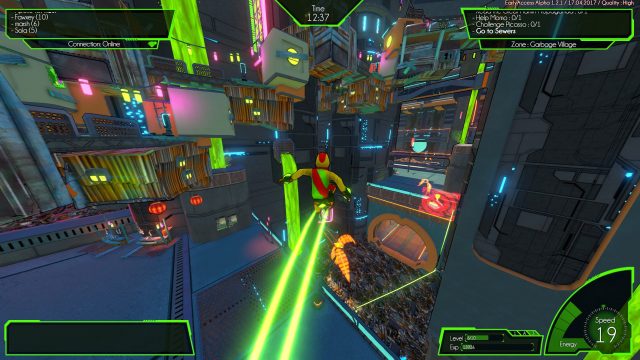
You’ll undertake a variety of gameplay challenges throughout Hover City as well, as you aim to overthrow the Great Admin, who has outlawed video games and entertainment in the city. This feels very similar to the sensibilities of Jet Set Radio, naturally, and also feels like it’s taking at least a bit of inspiration from EA’s more recent Mirror’s Edge games, which have similar narrative themes and parkour-based gameplay. Once you’re past that establishing objective of overthrowing the Great Admin though, much of Hover isn’t really about the story. Instead, the game operates much like an MMORPG, where it’s broken into various missions and challenges that you can take on at your leisure, whether alone or with friends, complete with potentially allowing random strangers to join you in a shared world setting. As you perform tasks and complete challenges, you’ll level up and rank up your character, opening up more upgrade capabilities and mission opportunities in the city, respectively.
The shared world gameplay style is an especially big design element that aims to separate Hover from the single-player-focused Jet Set Radio games that inspired it. With a group of friends, the game can indeed be especially fun too, especially if you focus on balancing out your crew with varying sets of stats and advantages. That said however, if you don’t have friends to play with, Hover isn’t quite as fun, especially since random strangers aren’t usually inclined to help you out, or pay much attention to you at all. If you’d rather not be fussed with dealing with other players, you can disable online interactions completely and play Hover fully by yourself, though this does make the game more difficult, especially when several missions don’t feel as effectively balanced for solo players, and seemingly demand a group to be played with any degree of efficiency.
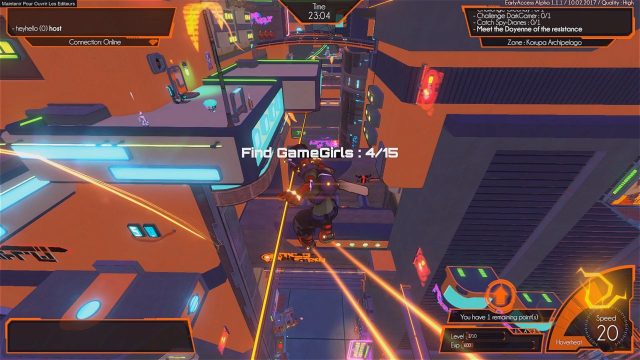
The better game modes of Hover can still be enjoyed fairly easily by solo players though, chief among these being the races. The race challenges are definitely the most fun and best designed among Hover’s gameplay elements, since they’re thrilling, speedy, and as long as you’re not taxing your computer by cranking the visual settings, completely smooth at all times. Better still is that Hover features an especially great mechanic in the rewind button, which lets you undo slips, falls and other such mistakes during your navigation efforts by restoring your gamer character to a previous place in the area. Bear in mind however that, handy as it is, the rewind button doesn’t rewind time, so if you use it to put yourself back on track in a race, it won’t change the fact that your opponent has probably blown past you.
Other challenges around Hover City include finding collectibles, smashing up Spybots, hacking into terminals, spraying graffiti, and making deliveries, all of which are technically fine for the most part. The game’s controls do sometimes feel a little loose and unreliable though, which can make some game modes less fun and more frustrating than they probably should be, even though the rewind button proves to be a saving grace here. The fact that you need to hold a button to grind and point you to objectives however is particularly problematic, especially since grinding in Jet Set Radio was automatic.
This gameplay clumsiness is most evident during one of the game’s least enjoyable mission types, Gameball, which has you trying to grab a ball and toss it into a chute-like basket before your opponents can. Unfortunately, there’s a lot of Gameball challenges in Hover too, which often highlight the shakiness of the A.I. and the wonkiness of some of the game physics. There’s never a real sense of strategy to Gameball, and at worst, it can feel like a challenge built around blind luck, since you just have to hope that the ball rolls near you, and goes where you want to go whenever you try and throw it.
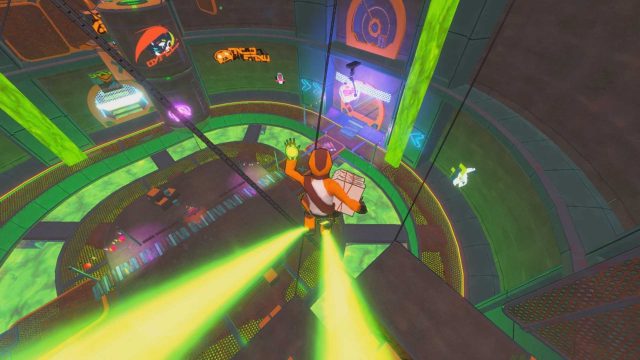
You can’t fault the fact that there’s plenty to discover in Hover City on your way to overthrowing the Great Admin though, so you do get your money’s worth with Hover’s $19.99 USD/$21.99 CAD price tag. Hover supports both mouse-and-keyboard inputs and controller inputs in its PC build as well, though getting Hover to properly recognize controllers can be a bit of a hassle, since you have to go through the menus and load a proper configuration for both Xbox controllers or a PS4 controller, rather than just having the game recognize them automatically. Rebinding gamepad buttons is also a bit of a chore if you want to do that (though the default gamepad controls are certainly fine), since they don’t display the button icons, and instead display raw code, meaning that players won’t have much of a clue as to which functions they’re re-assigning to which buttons, without a considerable degree of memorization. If you’d rather not bother with all that, then Hover is perfectly playable with a mouse and keyboard, though it does admittedly feel like it’s designed with a controller in mind, so it might be worth putting up with the couple of extra steps to get a game controller at the ready.
Those seemingly needless hurdles with doing things as simple as setting up a controller highlight the main issue with an otherwise decent game that’s clearly made with plenty of heart, and that’s the fact that Hover’s design just fights against the player in way too many places. The clunky navigation being such a chore, and several mission types just never managing to be more than boring and/or frustrating, will wear on players’ patience, and will probably hurt the appeal of Hover’s gameplay to anyone beyond the starved crowd of avid Jet Set Radio fans. Even some Jet Set Radio fans might end up being a bit let down that so much of Hover feels noticeably less polished than its Dreamcast inspiration, sadly making it come off as a pale imitation at its worst, rather than a truly worthy spiritual successor.
Hover: Revolt of Gamers has its moments of fun, and if you happen to be part of an especially patient gaming group that all love Jet Set Radio, then this is definitely the game for you. For everyone else that’s less certain and more curious though, you may want to hold off on purchasing Hover in its current PC build at least, since its upcoming console versions may present a more intuitive and reliably fun experience. That’s not guaranteed of course, but hopefully by then, the navigation issues and clunky interface will be ironed out to a greater degree than they are on PC, where they still feel like they’re trying to shed the molting from this game’s tenure on Steam Early Access.
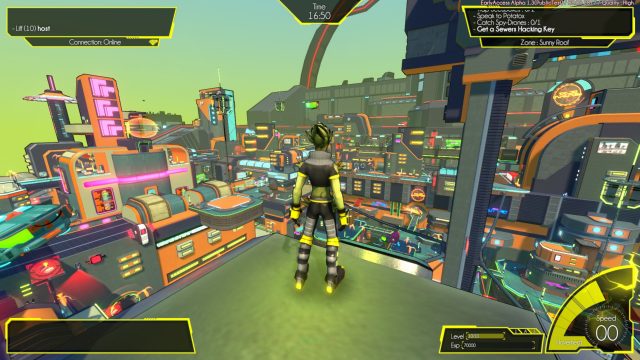
Thus, it’s unfortunately true that Hover does fall shy of its potential, but there is an audience for it. You’ll have to fight through several annoyances and design issues, but if you can get to the speedy, colourful heart of Hover, you’ll find that nostalgic, lovable game that it so badly wants to be, at least to some degree. It’s just too bad that the game demands so much patience and nostalgia to forgive several of its very apparent flaws, which makes its ideal audience smaller than it ultimately deserved to be. There’s nonetheless fun to be had in Hover City, but there’s more of it in the established games that Hover is so clearly trying to chase.
This review is based on a PC copy of, “Hover: Revolt of Gamers”, provided by the developers

